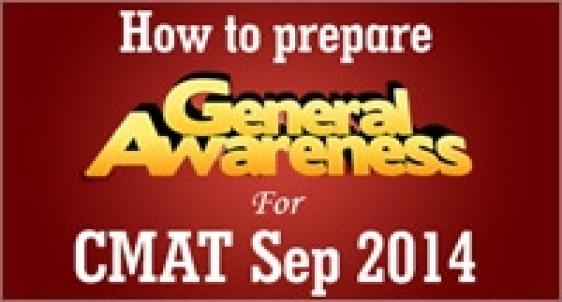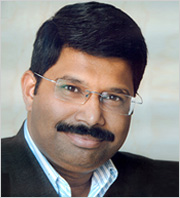
Questions on General Awareness in CMAT Sep 2014 examination will be placed to test the knowledge and IQ of the MBA/PGDM aspirants. A well educated person is expected to have at least a good knowledge of national and international affairs taking place. In this article Prof S K Agarwal, expert on CMAT preparation shares the importance of General Awareness and key tips to prepare this module
An average human being is affected, in many ways, with the events going on in the country or in the world; in the business, finance, political or social life. The world of sports, cinema and the various awards associated to them has been the key interest areas-where questions are framed in CMAT. Literary world of authors-their works, famous personalities, inventions and discoveries, important events, revolutions that changed the world scenario are loved by the examination paper setters when they prepare a set of questions on conventional General Awareness.
How important is General Awareness in CMAT
There will be 25 questions based on General Awareness in CMAT in the form of MCQs (Multiple Choice questions). Every correct answer will award you 4 marks improving your score and awarding you higher place in merit. Since there is no sectional cut off in CMAT and all the 4 sections have equal number of questions, General Awareness will play the same role in pushing up your merit position in CMAT as other sections can do.
The importance becomes more prominent when there are certain confusing names, events and the aspirants tend to forget the exact description which means you may not be so good to manage the future affairs with this weakness. For example difference among the abbreviations like G-8, D-8, G-15, G-20, NATO, OAS, OPEC, OAPEC, OECD, OIC, APEC, ADB, ASEAN, EEC, EU, EFTA, SAARC, WCC, WTO, should be well understood and remembered in context so that you may not forget the same in the testing room.
Corporate top brasses like Mr Ratan Tata, a house hold name, who is known for his sharp memory in remembering and recalling the names of thousands of employees of his company and his natural instinct to call the each employee by his name filled the heart of his subordinates with pride which always worked as a booster for more dedicated working.
How to prepare for CMAT General Awareness
All the Candidates, in one or the other way, are enriching their General Knowledge on the topics they like and are inclined to. The need is to understand the basics “How and what to prepare to improve the General Awareness”.
In fact, study of any subject is not as vast as the study of General Knowledge or as you put it General Awareness. But on the other hand, the best part on preparation for this section is that you do not need any special skill set as required for Quant and Verbal. What you need is your inclination and interest in regular reading of books and periodicals.
You might remember there are certain events that leave some bitter-sweet memories and leave a permanent mark in your memory. Similarly if you read the stuff with interest you will surely remember it.
You are still left with 2 months to CMAT Sep 2014. Rest assured you can prepare, revise and groom the General Awareness very well during this period, if you could attend and follow the below given preparation tips.
-The time for crawling preparation is over and the need is to shed the human nature of waking up at the eleventh hour.
-Two months are sufficient to prepare, revise, refresh well in this area. The tips to various areas of preparation are appended. You are required to meticulously follow the guided path and rest assured- if you do it, you will succeed.
-The Division – Before beginning to go for preparing the General Knowledge, you may divide the General Knowledge section in four parts - A. Conventional B. Business, Finance & Economy based C. Current Affairs India (Political, Social, Sports, Films, awards etc.) D. International (personalities-past & Present, global events etc.)
-Each part has to be given due weightage. Conventional GK-available in books; Current GK- based on current reading of newspapers and periodicals; Business & Economics GK -for example changes in Fiscal and monetary policy, CRR, Repo Rate, Devaluation and up valuation of Rupee. Please remember current GK-whether Business, national and international has an on-going preparation method and thorough reading of the newspaper only can keep you updated.
Stuff to read
1.Conventional –Good books on GK are available in the market and may be considered the best to prepare in a short time like Manorama Year Book, General Knowledge refresher, General Knowledge by S. Chand & Co. and so on. Devote a few minutes every day and try to learn this type of GK as much as possible. You may even mug it up-if you can but better way will be to relate one event to the personality, it will help you to prepare more than one question in a single reading. You may have questions based on the topics like Authors of the books, Historical facts & events, Personalities, places, questions based on inventions, discoveries and Geography, Physics, Chemistry, Biology etc
2. Business, Finance & Economy –This is one of the most favorite sections of GK that appear in the CMAT entrance examinations. Business and finance oriented General Knowledge improves your understanding of economic environment, strengthening your IQ and making you better equipped to face the Group discussions and Personal Interviews. Try to cover hot topics in Business, Finance and Economy. Going through them will help you to prepare better for your forthcoming CMAT examination. Following tips will be a great help to you-
i) Please read whatever stuff is available on such topics as you may confront these questions in different manner like ‘ What is the current CRR’, ‘Difference between CRR & SLR’ ‘ Instruments for money control’, “The authority that can change the Bank Rate of the Country” , ‘Which is the petroleum product from which subsidy has been fully withdrawn’, ‘Budget speech of the President marks the beginning or the conclusion of budget session’ ‘ Where the budget is presented first in Loksabha or RajyaSabha’, ‘Which company is not included in the NAVRATNA companies of India’ and so on.
ii) Regularly read the business, economy page of newspapers like The Times of India, The Economic Times periodicals like The week, India Today, The Economist – mark the striking events, read editorials and other articles analyzing various national and international events. Year books, purchased by you, will also be a good help in the preparation.
3. Current Affairs – India - Put more emphasis on last few years’ events in the country – Important changes, Events like Cricket World Cup, Victory at Lords after 28 years, Recent announcements by Government, Commonwealth games, creations of additional states, appointments – Private and Public sector, awards etc. Global happenings that mark their impacts in the country must be well read. Although there is no syllabus for GK, you must brush up whatever you have read. Draw a quick plan to revise and learn.
Regular reading of the national events in the newspapers like The Hindu and the above mentioned ones will be quite advantageous. You need to spend around 15 minutes a day to it and one event will link you to another. Read the associated events as they are also the probable questions.
4. International - Answers to Questions based on International affairs sometimes are difficult to distinguish due to the close similarity in names, cities, figures etc. So the important part is to find out some key word in the articles wherefrom you learn and prepare the GK.
Put more emphasis on last decade events and global happenings like global depression, mutiny in certain countries, economic swings that made impact on Indian Economy, Appointments – like the second term of Obama as the President of America- his core international policies that may impact our Country, All about Malaysian Planes who were Lost and Shot in one year, their names, air route, what happened.
Probable Questions
Following are a few indicative GK questions for CMAT Sep 2014. Aspirants are advised to move on to prepare more and more questions on all the topics
Set of Questions
1. Monetary policy of the country is decided by the
1. Ministry of Finance – Government of India
2. Group of Nationalized and commercial banks of the country
3. Reserve Bank of India
4. Government of India in consultation with leading corporate groups
2. Increasing the Cash Reserve Ratio (CRR) will –
1. Expand the money supply in the country
2. Contract the money supply in the economy
3. Neither expand nor contract the supply of money
4. The term is not related to Money supply but the demand of cash
3. National Bank for Agriculture and Rural Development (NABARD) is-
1. Direct credit provider to Individuals in Rural areas
2. Rural Bulk credit provider and functions as a refinancing institution
3. Provides seasonal credit to farmers only
4. Provides credit to Rural housing only
4. Special Drawing Rights (SDR) defined and maintained by
a) World Bank
b) IMF
c) Federal Reserve
d) European Central Bank
5. Gilt edged market refers to
a) Government securities
b) FII
c) Bullion market
d) None of these
6. Where is the headquarter of Green peace
a) Paris
b) New York
c) Madrid
d) Amsterdam
7. Regional Rural Banks were given freedom to fix rate of interest from which year
a) 1996
b) 1999
c) 2003
d) 2007
8. Anil Kakodkar committee is related to...
a) Airlines safety
b) Nuclear reactors
c) Sugar pricing
d) Railway modernization
9. Which of the following regulates the commodities trading market?
a) SEBI
b) Forward Markets Commission
c) RBI
d) IRDA
10. Softbank is a mobile operator of which country
a) China
b) Norway
c) Japan
d) Singapore
Important note
No doubt the pressure becomes more when the examination is at hand; so have a balanced approach. Too much of mugging or burning mid-night oil may not be so effective as you may get confused or may forget whatever you learnt last night. It is better to revise the items that you have already studied and keep pace to keep you up-to-date.
Since examination paper must have been prepared, at least a fortnight before the examination date, you may eliminate such events which take place a fortnight or so prior to examination date.
For Latest updates on CMAT Sep 2014 exam, Click here: Ask your queries on CMAT 2015-16 with Experts
Answers
1. (c) Reserve Bank of India
2. (b) Contract the money supply in the economy
3. ( b) Rural Bulk credit provider and functions as a refinancing institution
4. (b) IMF
5. (a) Government securities
6. (d) Amsterdam
7. (a) 1996
8. (d) Railway modernization
9. (b) Forward markets commission
10. (c) Japan
Related links:
CMAT Sep 2014: Know the CMAT exam pattern and importance
CMAT 2015-16 First Test on Sep 25 to 29, 2014; CMAT Registration opens from July 3
Stay tuned to MBAUniverse.com for more preparation tips for CMAT Sep 2014 General Awareness



























